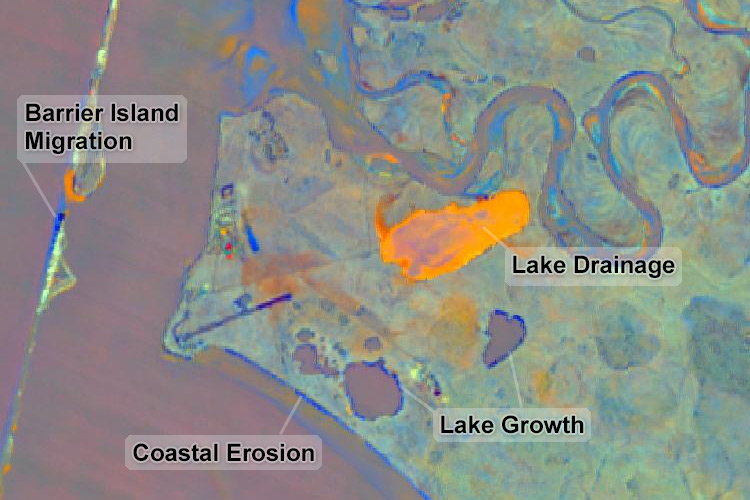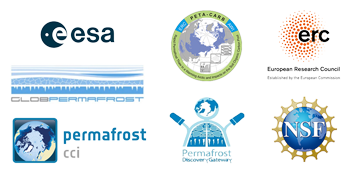About the Arctic Landscape EXplorer (ALEX)
The Arctic Landscape EXplorer (ALEX) presents change data derived from remote sensing analysis for permafrost regions throughout the Arctic. Interactive maps provide up-to-date information on land surface changes, hotspots of disturbance, and potential areas of active permafrost thaw and erosion. Using tailored visualizations and story maps as a means to more effectively communicate scientific observations of change, the tool is specifically addressing non-scientific user communities, stakeholders, and rights holders in the Arctic.
Data on land surface changes

Change map of Point Lay, North Slope, Alaska.
In order to obtain information on permafrost landscape change presented in this tool, remote sensing analysis was applied. The change analysis covers a time period of 20 years and uses cloud-free pixels in images with less than 70% cloud-cover for the months of July and August.
With the dataset, permafrost disturbances are mapped at high spatial resolution over large regions to quantify landscape change, hydrological dynamics, and permafrost vulnerability. Key permafrost region disturbances are detected across continental-scale spatial domains and can be assessed quantitatively. They include lake drainage, coastal erosion, thermokarst lake expansion, retrogressive thaw slumps, fire scars, and infrastructure expansion.
In the change map, flashy colors indicate a substantial change in the landscape. For example, coastal erosion (a trend of a land surface transitioning to a water surface) is depicted in dark blue colors, while coastal accretion (a trend of a water surface transitioning to a land surface) is depicted in bright orange colors. Drained lakes appear in bright yellow or orange colors, depending on the soil conditions and vegetation regrowth. Fire scars are a further common feature, which can appear in different colors, depending on the time of the fire. In addition, changes for the indices Brightness (changes in soil), Greenness (changes in vegetation), and Wetness (changes in surface wetness) can also be displayed individually.
Team behind ALEX
ALEX is developed and maintained by a team of scientist at the Permafrost Research Unit at Alfred Wegener Institute Helmholtz Centre for Polar and Marine Research.

Tillmann Lübker
lead developer and conceptualization, Geospatial Data Scientist

Ingmar Nitze
remote sensing analysis (change map), Permafrost Remote Sensing Scientist

Sebastian Laboor
conceptualization and technical support, Technician

Anna Irrgang
conceptualization, Coastal Geomorphologist

Hugues Lantuit
Deputy Head of Permafrost Research Unit, Head of the Arctic Coastal Erosion Research Group

Guido Grosse
Head of Permafrost Research Unit, Lead of the Arctic PASSION Permafrost Service
Arctic PASSION
This portal is part of the Pan-Arctic requirements-driven Permafrost Service of EU Horizon 2020 Arctic PASSION project. The research project aims to refine, improve and extend pan-Arctic scientific and community-based monitoring systems, with a focus on creating a coherent and integrated Arctic observing system that is tailored to the needs of users or stakeholders.
Funding
Arctic PASSION project has received funding from the European Union’s Horizon 2020 research and innovation programme under grant agreement No. 101003472.
Acknowledgements
We are very grateful for the support we receive from many different colleagues at the AWI Computing and Data Centre. We would also like to express our gratitude to all of our international partners who have contributed to the success of the ALEX tool through their feedback, advice, and fruitful discussions.

The dataset on land surface changes has been developed within the following research projects:
- PETA-CARB, funded by the European Research Council (ERC)
- GlobPermafrost, funded by the European Space Agency (ESA)
- CCI+ Permafrost, funded by the European Space Agency (ESA)
- Permafrost Discovery Gateway, funded by the National Science Foundation (NSF)
Further information
Related publications
Lübker T., Nitze I., Laboor S., Irrgang A., Lantuit H., and Grosse G. (2024): Presenting land surface changes through the web-based Arctic Landscape EXplorer (ALEX) to permafrost communities – a permafrost service. International Conference on Permafrost (ICOP 2024), 16-20 June 2024, Whitehorse (Canada). HDL: 10013/epic.1a45e5a5-90bc-4385-8588-520424158329, Details: https://epic.awi.de/id/eprint/58864/
Lübker T., Nitze I., Laboor S., Irrgang A., Lantuit H., and Grosse G. (2024): Visualizing data on permafrost degradation in a pan-arctic pilot service aiming at a non-scientific audience. 13. Deutsche Klimatagung, Potsdam, Germany, 12–15 Mar 2024, DKT-13-19. DOI: 10.5194/dkt-13-19, Details: https://epic.awi.de/id/eprint/58254/
Lübker T., Nitze I., Laboor S., Irrgang A., Lantuit H., and Grosse G. (2023): A web-based portal for serving geospatial information on permafrost disturbances to permafrost communities. Poster presented at the European Conference on Permafrost (EUCOP 2023), 19-22 June 2023, Puigcerá (Spain). HDL: 10013/epic.e696abb5-f081-4427-b8d2-1e892cdc61b8 Details: https://epic.awi.de/id/eprint/58253/

Logo
The logo of the Arctic Landscape EXplorer was created with the help of AI. In an iterative process, a rather long description of what the logo should look like was chosen. The resulting image was then vectorized and slightly reworked (e.g. the north star was added).
Release Notes
ALEX had its official launch during a side event of the Arctic Frontiers Meeting in Tromsø, Norway, on January 29th, 2024. All updates to the tool, except for minor changes, are documented in this section.
2025-07-24 (Data Update)
- Update: The change data presented in this tool now covers 2005-2024 (previously 2003-2022)
- Update: The underlying process was further refined reducing striping artifacts
- New: Both change periods (2003-2022 and 2005-2024) can be compared with the «compare maps» function
2025-03-24 (Major Release)
- New: Stroy map on «shore erosion» now available
- New: Added a tool for easy map comparison using fade and swipe functions
- New: The URL changes when the map view is modified (e.g. by zoom, pan, layer choice)
- New: Added a tool for easy sharing of map locations
- New: The hillshade of the ArcticDEM is now available as an additional background layer
- Update: Enhanced version of the «at a glance» section on the home page
- Update: Photos of team members updated
2024-09-04
- New: Included Spatineo service for tracking usage of ALEX' map component
- New: Indivudual privacy statement added
- Update: List of related publications updated
2024-04-02
- Bug fix: Layer change for change data now also working in Chrome and Edge browsers
2024-03-26
- New: Added INTERACT stations, including information in pop-ups
- New: Separate imprint page added
- Bug fix: Wetness layer styling in "light" visualization mode now works correctly for change data
- New: Added first page for custom local view
